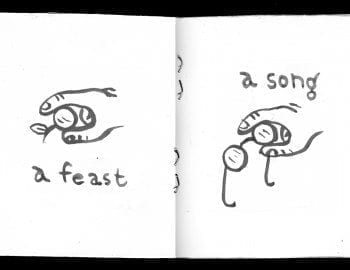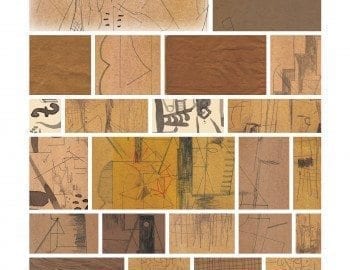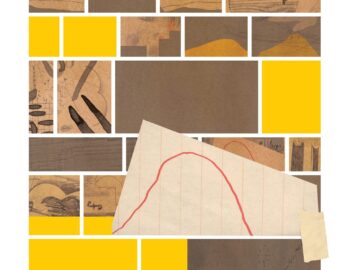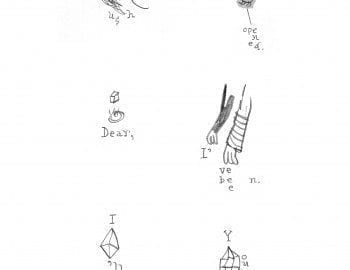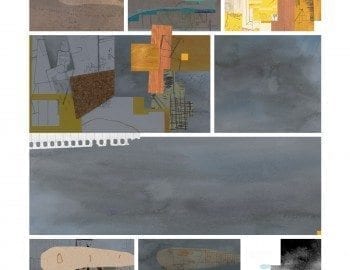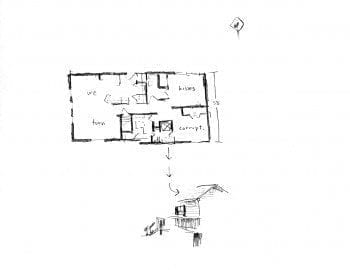Warren Craghead is an artist generally beloved by cartoonists and readers lucky enough to have found his work. Mentioning his name never fails to elicit a quick "oh, yes I think his drawing is great," but he is woefully under-read and-under discussed. Part of this is because his strongest work, How To Be Everywhere, is a publication with an extremely limited run (although that's no excuse--the readership of comics in general is extremely limited to begin with, and could sync up just fine with the amount of copies of How To Be Everywhere if it wanted to). More importantly, though, what Craghead is doing with his art is rather daunting to describe, leading to inevitable tongue tying after the confession of admiration. I have the same problem myself--which is why I thought a series of short statements from Craghead himself might be in order. I hope this might get the ball rolling in terms of thinking about what Craghead is doing. In the current comics landscape, where experimental approaches seem to be hastily backed away from more and more after the giddy embrace they received about five years ago, Craghead is as important as ever.
Austin English: Your drawings feel incredibly personal to me, but not in any simple version of the word 'personal.' They seem like your own world of symbols that express something that is very much yours, and I don't see those symbols anywhere else. For the drawings that you publish, how much work is done in developing them (in sketchbooks or studies) before you share them publicly? Or are the images you publish visual ideas that you're still developing?
Warren Craghead: I don't do much preliminary drawing at all. I don't sketch or "pencil" but I do draw things over and over until they seem right. By "right" I mean interesting and strange. My work is sort of stories that tell themselves or that are found by drawing them. It sounds a little corny but I wander around.
As for the personal, I've always been interested in the idea of turning images and words into each other. Concrete poetry (like some of Guillaume Apolliniare's work), Mixtec screenfold histories, Cubism, medieval illuminations. I once tried to learn to read Egyptian hieroglyphs - I still use some of them in some work. The idea of mixing them up is old.
A personal vocabulary forms naturally for an artist. I'd like to think I can draw anything but I know I gravitate towards drawing things I like to draw. Houses, dirt, lights, trees. People, not so much. There's reasons for all that, I guess.
English: Can you expand on what those reasons are? The absence of people is almost a signature of your work (although, for me, there is a feeling of "people" in all of it).
Craghead: The biggest reason is that most of my work is non-cinematic in that I don't want to make little windows that the viewer peers through to see something happen, like in a movie. I want drawings that come out at the viewer, that are experiences themselves. For me this idea comes from Cubism and its insistence that a painting be both a representation of something and an honest object in the world.
Dang, it only took me two questions to start spouting off about Cubsim....
I enjoy quite a lot of great work that does employ cinematic devices in storytelling - most comics from Kirby to May do this, though there's more and more other traditions being used these days. I guess I've just veered off onto another path.
I am interested in people - How To Be Everywhere is all about a person, it's a sort of biography of Apollinaire but I only really draw him once. I tried to make a presence there without specific depiction.
English: "An honest object." Is an honest object a shape we've never seen before? A shape that you have in your mind that doesn't exist anywhere else?
Craghead: To me an honest object is one that is itself. So, for example, a painting that doesn't only strive to be a window into another world, but one that might depict something but is also clear about what it is -- wet colors moved around on a 2D surface. Comics already do this with cartoons -- they show something but they are also clearly ink on paper. In my work I'm not interested in having a reader "get lost" in my story, I want my things to jump out and participate in their world. Towers and mountains not pits and windows.
I'll add that in other artist's work I very much like the cinematic and "window" ways of working. I just want to do something different than that.
English: I feel like I have that in me too...liking the "cinematic" style in other artists' work, but my work comes out differently. Sometimes I sit down and say, "This will be a normal comic from me, finally!" But it never comes out that way. But sometimes just looking at an old Joe Maneely comic will be more of a charge for me then looking at something that's more stylistically similar to me. Just the idea of comics. How important is the idea of comics for you?
Craghead: I really like the idea of words mixing up with images to do something. Is that comics? I also like making little books, things to give out, too send out into the world like seeds or viruses. Is that an idea of comics too?
I'm with you on old work that might be totally divorced from what I make. Old Infantino or Wayne Boring comics make me happy in some comics area of my brain. I don't think they affect my work much though - it's like watching TV. Well, not even that because I draw from TV sometimes. Lost comics. Project Runway comics.
English: When you make those little books and things to give out, at this point how connected is all that to your day to day life? Is art-making a natural thing like taking your kids to the zoo or is it in a different part of your brain?
Craghead: You're asking something I've been thinking about a lot lately. Comics-makers like Oliver East and Franklin Einspruch have a great sense of place and life in their work. They do sort of auto-bio work, but without drama (well, without much drama). I see possibilities in what they do for comics that still stay close to one's own life but don't always illustrate dramatic situations. In some things you do I see situations that are so sunk into the materials used and the play of drawing that the work also moves away from dramatic illustration. Do I think about things like that?
I have very little time to draw between my day job and my family and I think that has made my work move more towards being integrated into my life more. I'll draw a lot while doing other things (eating, playing with kids, driving) and that ends up being used in work I make.
Recently I've made little books that commemorate things - a trip to Portugal, an art show, my brother's wedding, my daughters being born, their birthdays. I like reading Basho's old Japanese travelogues where he adds some poems in with his story, like aesthetic punctuation. Again, life and autobio without just drama. Experience.





